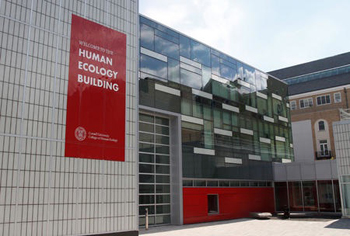Cornell Welcomes First LEED Platinum Building
 ITHACA, N.Y. — Cornell University has recently unveiled its first LEED Platinum building at the school’s Ithaca, N.Y. campus. The Human Ecology Building was awarded the prestigious honor for its sustainable building commitments.
ITHACA, N.Y. — Cornell University has recently unveiled its first LEED Platinum building at the school’s Ithaca, N.Y. campus. The Human Ecology Building was awarded the prestigious honor for its sustainable building commitments.
New York City-based Gruzen Samton Architects designed the building by using sustainable design features to highlight Cornell’s commitment to energy conservation.
“The building is designed to use 32.2 percent less water [that is safe for consumption] and 46.6 percent less energy,” said Kyu-Jung Whang, vice president for facility services at Cornell.
Erin Moore, project associate of utilities energy management, said the building demonstrates an ongoing effort by the university to promote sustainable design. Designers used materials that were safe for the environment as well as materials that are intended to help low energy costs for the end user.
The building was made from materials that serve to improve the indoor air quality for its occupants. Its glass façade allows for daylight harvesting — which increases the use of natural light and omits the need for excess artificial lighting in the building.
Whang said that recycling was also a huge priority when it came to the design and construction of the new building. More than 1,050 tons of waste from construction was diverted from disposal in landfills through recycling and reuse.
“We have diverted 75 percent of on-site generated construction waste from landfills, 33 percent of the total building materials content have been manufactured using recycled materials and 23 percent of the materials have been produced within 500 miles of the site,” Whang said in a statement.
The school not only went for LEED Platinum to make a statement for energy efficiency, but also wanted to closely monitor the progress of the building in terms of energy savings. Ted Boscia, assistant director of communications at the Human Ecology College, said in a statement that the building would soon install a feature to help keep track of its energy usage.
“One exciting feature is the real-time system for monitoring the building’s energy use that will soon be connected to an online dashboard accessible to all,” Boscia said in a statement. “It has great potential to be used by building occupants to attempt to lower their energy use and by professors and students in facilities design and management to study the building’s efficiency.”
The new LEED Platinum building may be the first at the school, but hopefully not the last, according to the university.
The Green Building Oversight Committee, which works to achieve the university’s green building standards, has drafted requirements that order all construction projects costing more than $5 million in project costs, to achieve at least LEED Silver certification.
“This is our first LEED Platinum building, but it will not be our last,” said Whang in a statement. “Cornell’s commitment to sustainability extends to every level of leadership at the university. This platinum rating is the culmination of planning and effort by people all across campus who have been committed to this outcome for many years.”
